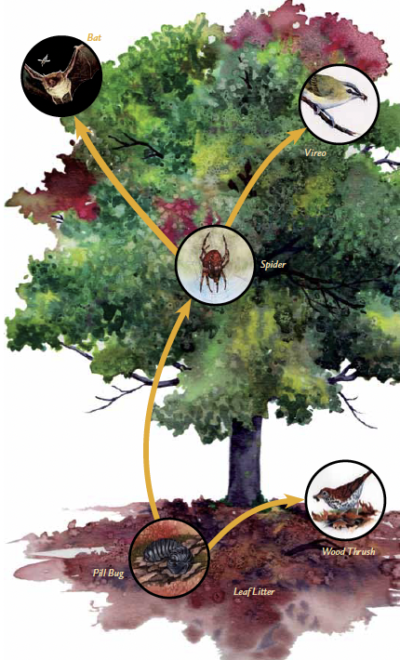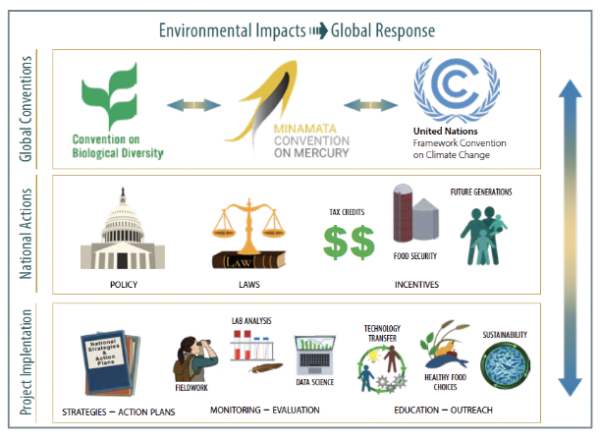Newswise — About a decade ago, BRI hosted a Bio Blitz at our River Point bird monitoring station in Falmouth, Maine. For 24 hours, researchers, citizen scientists, and nature enthusiasts walked the 41-acre conservation land to capture and catalog the variety of fauna and flora found on those acres.
During the early morning start of the blitz, children and adults began to canvass the property, butterfly nets and binoculars in hand, to find every and any living thing they could—from plants, insects, reptiles, amphibians, to birds and small mammals. BRI staff set up stations in the barn where participants could bring their specimens for identification. During the night, our intrepid field crews set up mist nets to capture any bats flying through the area.
This event was not just for fun, although it was a lot of fun for those participating. The goal was to identify the wide range of life forms in the ecosystem that is the River Point Conservation Area. Pill bugs eat leaf litter; spiders and birds eat pill bugs; bats and birds eat spiders. In any food web, all are connected and dependent upon one another.
Ten years ago, biodiversity was just an obscure word to many people. Now, that word holds the key to our survival on this planet. BRI’s Bio Blitz foreshadowed the studies we are currently conducting, but now we call them biodiversity surveys and we send field crews to the far reaches of the globe. No longer just a fun local activity, these surveys are a necessary way to help stave off serious loss of all manner of fauna and flora.
A Global Response to Global Crises
Global biodiversity encompasses a rich matrix of ecosystems, the diversity within species, and the interactions that occur between species within ecosystems. Every ecosystem and food web depends on this variety – when a piece of the web is destroyed, the system weakens. A weakened system cannot withstand continued assault from environmental stressors, such as pollution, unpredictable weather patterns, or habitat loss. Somewhere we reach the tipping point from which the ecosystem cannot bounce back.
So, what to do? Join forces.
Recognizing the Connections
A plethora of ongoing scientific studies are revealing and confirming the interconnectedness and complexities of the variety of life on Earth. The loss of biodiversity threatens our food supplies, opportunities for recreation and tourism, and sources of wood, medicines, and energy. The loss of species also interferes with essential ecological functions. The underlying causes of biodiversity loss are often complex and stem from many interrelated factors such as habitat loss, development, overfishing, invasive species, industrial activities, and pollution.
Mercury and Biodiversity
BRI has been working with the United Nations for more than a decade to study mercury contamination around the world through the UN’s Minamata Convention on Mercury. Mercury exposure poses a threat to ecosystems and their inhabitants, which in turn could affect the biodiversity of a given ecosystem. It stands to reason that we should share our knowledge with those who are focusing on threats to biodiversity. Last December, BRI scientists formally connected with researchers and policymakers at the Convention on Biological Diversity’s conference in Montreal to learn about their approaches to protect the world’s vast biodiversity. This past fall, BRI presented recently published research to UN delegates in Geneva on the impacts of mercury to biodiversity. BRI has also established a Biodiversity Program to continue to study this issue further.
Sharing Knowledge on Impacts to Climate Change
On another front, BRI is addressing the impact of climate change through its Center for Climate Change and Conservation. Levels of mercury and carbon—both naturally occurring elements—are being released and remobilized by human activities at increasing rates. As a result, these levels far exceed their natural states of circulation, creating impacts that result in harm or damage to human and ecological health.
Mercury pollution. Biodiversity loss. Climate change. Each of these crises has been met by a global convention (or treaty): the Minamata Convention on Mercury, the Convention on Biological Diversity, and the Framework Convention on Climate Change. These conventions share the commitment of the Parties to organize actions on the national level to support related national and international policies and regulations. In support of these efforts, the UN’s Global Environment Facility (GEF) manages and allocates funds to advance action plans, monitor activities, and raise awareness.
A clear challenge is to better coordinate these global efforts to have greater impact addressing these threats to people and nature. BRI’s scientists are on the front lines of this challenge, working to share our expertise. If these Conventions are successful, global levels of redistributed mercury will decline, carbon emissions will decline, and more carbon emissions will be sequestered. If the reduction of these direct threats to biodiversity is enough, the hope and goal is that global health will be enhanced and the biodiversity crisis can be averted.
More stories on https://briwildlife.org/bri-blog/.




